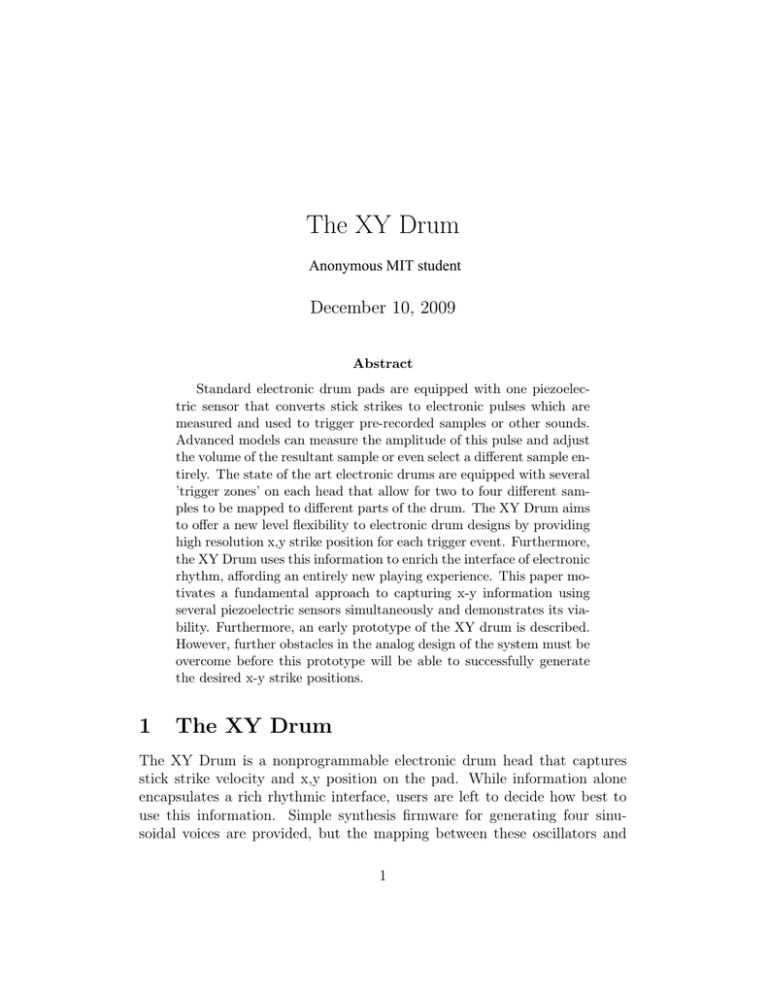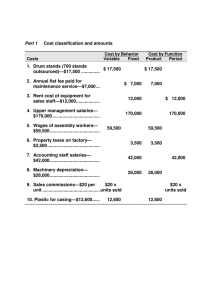Document 13622796
advertisement

The XY Drum
Anonymous MIT student
December 10, 2009
Abstract
Standard electronic drum pads are equipped with one piezoelec­
tric sensor that converts stick strikes to electronic pulses which are
measured and used to trigger pre-recorded samples or other sounds.
Advanced models can measure the amplitude of this pulse and adjust
the volume of the resultant sample or even select a different sample en­
tirely. The state of the art electronic drums are equipped with several
’trigger zones’ on each head that allow for two to four different sam­
ples to be mapped to different parts of the drum. The XY Drum aims
to offer a new level flexibility to electronic drum designs by providing
high resolution x,y strike position for each trigger event. Furthermore,
the XY Drum uses this information to enrich the interface of electronic
rhythm, affording an entirely new playing experience. This paper mo­
tivates a fundamental approach to capturing x-y information using
several piezoelectric sensors simultaneously and demonstrates its via­
bility. Furthermore, an early prototype of the XY drum is described.
However, further obstacles in the analog design of the system must be
overcome before this prototype will be able to successfully generate
the desired x-y strike positions.
1
The XY Drum
The XY Drum is a nonprogrammable electronic drum head that captures
stick strike velocity and x,y position on the pad. While information alone
encapsulates a rich rhythmic interface, users are left to decide how best to
use this information. Simple synthesis firmware for generating four sinu­
soidal voices are provided, but the mapping between these oscillators and
1
the trigger events are intentionally left blank so that users can experiment
with how to use this new interface. This mapping is specified via a simple
software interface that is uploaded to the XY Drum over USB. The classic
use case, although this has not yet been demonstrated, is to map frequency
on the vertical axis and decay on the horizontal. Thus pure tones at cer­
tain frequencies and with certain envelopes can be produced by striking the
pad at varying positions. Early data suggests that users should have no
problem triggering several notes simultaneously. This is possible because no
player is capable of producing truly simultaneously strick strikes. Incident
impulses are measured with a phase resolution of 20MHz (wave peaks can
be differentiated as long as they are 50ns apart). Furthermore, positioning
information depends on 1ms timing differential between wave peaks, which
is about the time it takes for sound to travel across the pad. Thus, unless a
player can play simultaneous strokes accurate to the millisecond, the system
should gracefully handle the gesture as two distinct strikes.
2
Measuring the Timing Delta
The first step towards building the XY Drum was to verify that timing in­
formation could be used to triangulate stick strike position. More complex
methods of measuring this information are possible. For example, field inter­
ference effects (technique used by most tablet displays) would be effective,
but would require special sticks with inductive tips. Resistive arrays are also
a possibility, and this approach is backed by several patents for x,y sensi­
tive drum pads (none have come to commercial fruition). This mechanism
is mechanically unsuitable, however, as the resistive top layer that does the
sensing tends to ruin the desired strike dynamics that players prefer. Am­
plitude triangulation is ruled out because it depends on the pad dampening
wave pulses as they transmit across the surface. This dampening effect would
make it impossible to recover velocity information about the strike, since am­
plitude would necessarily depend on strike position. Measuring the timing
delta between wave peaks is subject to non of the above issues. However, this
approach requires high frequency sampling not available on most electronic
drum interfaces. In fact, most drum triggers are samples at the audio rate of
44KHz, or sometimes slower, since that already exceeds the accuracy of the
player. In high quality drum pads such as those produced by Roland, the
piezoelectric sensor is coupled to the drum head with a thin metal interface.
2
This decrease any dampening, but sound travels very quickly through this
material. Depending on the metal, the speed of sound is usually near 3000
m/s. Thus wave pulses take about 3us to travel across a 10cm pad. While it
is technically possible to capture 100 million samples per second (MsPs), the
associated electronics cost would be too high (more than 200$). In a plas­
tic ’rock-band’ style drum, sound travels substantially slower. Experimental
results show that wave pulses take a full 1ms to travel across the pad. Un­
fortunately, this comes at a cost of substantial dampening, making velocity
retrieval difficult. However, this timing delta can be trivially measured to
produce ¡ 1mm precision in x,y triangulation, which is far less than players
can accurately differentiate. Rather than sample the piezoelectric sensors
and search for wave peaks, the signal is amplified so that any tap will rail to
the gain ceiling of 3.3V. This means that an ADC is not needed to measure
strike position, as this 3.3V can be used to trigger a digital interrupt on most
micro controllers. Velocity measurements are impossible in this configura­
tion, but can be easily obtained by sampling any of the 3 triggers (or all
three) and measuring the peak amplitude of impulses before they have been
amplified.
3
The Hardware
The piezoelectric sensors source the data pipeline, measuring stick strikes AC
pulses. In order to generate x,y information, there are actually three iden­
tical data pipelines sourced from three separate sensors. From the sensors,
the signal is rectified and amplified and then passed into an STM32F103
Microcontroller. This ARM Cortex M-3 Processor was chosen because it
has the requisite speed to measure the timing deltas while simultaneously
synthesizing sound or replaying samples. Furthermore, the simple program­
ming interface to this device makes it perfect to allow users to reprogram
the XY Drum to suit their sonic needs. The processor generates an acoustic
waveform that is modulated using PWM. This signal is then low pass filtered
and amplified before being passed to an integrated loudspeaker. In this way,
the XY Drum can operate as a freestanding device (once programmed) with
no need to be attached to further hardware to be used as a live percussive
instrument.
3
3.1
Conditioning the Signal
The piezoelectric sensor generates AC signals, and depending on the physi­
cal dynamics of drum pad there are no guarantees that the first wave pulse
will be measured as positive or negative. Thus the first stage in the signal
pipeline is a full-wave rectifier. This circuit leaves positive pulses untouched
while multiplying negative signals by -1. This filter comes at a cost, however,
reducing the peak voltage by .7V as required by the operation of the diodes.
Since both the positive and negative terminals of the sensor are technically
being measured as part of the signal the sensor is decoupled from ground.
This make the long leads in the circuit extremely sensitive to periodic noise,
namely the 60Hz electrical background noise common in most environments.
Filtering out this 60Hz noise while maintaining the original signal proved dif­
ficult and remains one of the principle roadblocks to a successful prototype.
In order to make the drum sensitive to even light taps, this rectified signal
must then be amplified. Ordinarily, light taps produce a .1V swing, while
hard strikes can produce wave peaks over 2V. The 60Hz background noise
hovers at around .05V in amplitude, which allots extremely narrow margins
between amplifying the .1V taps such that they exceed the digital transition
voltage (around 2V) without amplifying the 60Hz noise as well. The mi­
crocontroller will usually respond to input voltages above 2V, so the goal of
amplification is to achieve a precise gain of 200 so that .1V taps result in a
trigger, but .05V noise does not. In fact, this precision was never achieved,
and the current state of the XY Drum requires strong stick strikes in order
to cause a trigger event.
3.2
The Maple Microcontroller
The Maple Microcontroller is effectively a usb programmable ARM Cortex
M-3 processor with a lightweight library that exposes much of the processors
functionality. Two core features of this processor are used. The first is the
50MHz GPIO bus, that is configured to trigger separate interrupts whenever
one of the three input channels rise above 2V. In practice, these GPIO pins
are only accurate to 20MHz, although this did not adversely affect the per­
formance of measurement. Second, the integrated PWM peripheral is used
in order to generate the output signal without the need for a DAC. PWM
is common practice that encodes data in the duty cycle of a fixed frequency
square wave. In the XY Drum, the output PWM channel is configured to
4
Figure 1: Recitifcation and Amplification
5
produce a square wave at 1MHz, where the duty cycle can vary from 0% to
100% in 255 discrete steps. Generating this signal only requires one instruc­
tion per microsecond, since once the PWM channel is loaded with a duty
cycle, it generates the square wave without use of the processor. In practice,
this resource is more than sufficient to create high quality sine tones up to
and beyond the range of human hearing. The channel is, however, a little
audibly noisy due to the high frequency components of the carrier square
wave, and this noise is filtered out with a simple RC Low Pass filter.
4
Software
The software is composed of three principle components. The external in­
terrupts, the main state machine, and the signal multiplexer. Each of these
simple structures are described below.
4.1
Detecting Position With Interrupts
Interrupts are software routines that are separate from the main loop of
the program. These routines must be “triggered” by some external event.
Once triggered, the processor immediately stops executing whatever routine
is currently active, branches to the interrupt, and then returns to the routine
that was interrupted. Interrupt routines and main loop routines communi­
cated via shared global variables. Each of the three conditioned piezoelectric
sensors drive identical but independent external interrupt channels. The
psuedocode for these interrupt service routines are as follows:
global int x,y;
global bool trigger;
exti_isr_sensor0() {
disableAllInterrupts();
int count_sensor0=0;
int count_sensor1=0;
int count_sensor2=0;
int count=0;
while (1) {
count++;
if (readPin(sensor1)) {
6
count_sensor1=count;
break;
} else if (readPin(sensor2)) {
count_sensor2=count;
break;
}
}
if (count_sensor1 != 0) {
while (1) {
count++;
if (readPin(sensor2)) {
count_sensor2=count;
break;
}
} else {
while (1) {
count++;
if (readPin(sensor1)) {
count_sensor1=count;
break;
}
}
/* count_sensor0 is always 0, since we interrupted on it */
x = triangulateX(count_sensor0,count_sensor1,count_sensor2);
y = triangulateY(count_sensor0,count_sensor1,count_sensor2);
trigger=TRUE;
enableAllInterrupts();
}
4.2
Generating Sound with PWM and Wavetables
In order to avoid unnecessary overhead in the size and complexity of the
embedded executable, common programming libraries are omitted, such as
libc. This means that convience functions like sin and exp are simply not
available. To counter this, 4096 individual samples of sin(t) and e−x were
7
generated in python, the values were scaled to vary from [0, 255] in both
cases. These values were formatted in appropriate ASCII text and simply
copy-pasted into the source code for the XY Drum. The wavetable for sin
captures a single period, and the wavetable for e−x was manually windowed
to capture a decay from 254 down to 1. In this way, sin(x) (or e−x ) can be
computed via:
u8 sin(u32 x) {
x = x%4096;
return sin_table[x];
}
u8 exp(u32 x) {
if (x>4096) {return 0;}
return exp_table[x];
}
4.3
Coding a Drum
With these components, the simple drum state machine can be constructed.
In order to minimize processing overhead, only four voices are provided,
each defined by an amplitude, a frequency, and a decay rate. This limitation
easily satisfies the processing constraints of the microcontroller. In fact,
the limits were chosen conservatively. However, since the PWM signal is
generated by a separate processing peripheral and uses only 1 instruction
per microsecond, and the ISR is only triggered on very infrequent (compared
to the processor speed) strike events, nearly all of the 72 million instructions
per second that are available are unused. Thus a four voice limitation is
extremely conservative. In fact, there are enough left over cycles to mix
together dozens of samples simultaneously or add simple dsp filtering (like
reverb or delay) to the signal. These flourishes are beyond the scope of this
project, however.
void main() {
u16 voices_time[4];
u8 voices_freq[4];
u8 voices_decay[4];
u8 voices_amplitude[4]; /* not used */
8
u32 signal; /* the signal is really only
8 bits, so we have LOTS of
room for computational overhead */
cvi=0;
/* current voice index */
while (1) {
if (trigger) {
trigger=FALSE;
voices_time[cvi] = 1;
voices_freq[cvi] = y;
voices_decay[cvi] = x;
if (cvi++ > 3) {cvi=0;}
}
signal = 0;
count = 0;
for (int i=0; i<4; i++) {
if (voices_time[i] != 0) {
signal += sin(voices_time[i]*voices_freq[i])*
exp(voices_time[i]*voices_decay[i]);
count++;
if (voices_decay[i]*(voices_time[i]++) > 4096) {
voices_time[i] = 0;
}
}
}
signal = signal/(255*count); /* normalize out that
exp() goes to 255, and
we have ’count’ voices */
setPwm(output,signal);
}
}
There are a few features in the above pseudocode worth discussing. The
first is that voices who have run to the end of their decay (deay ∗voicesT ime)
are no longer added to the signal and are not incremented. They are dead,
only to be revived by future trigger events. Also note that this main loop is
not of static runtime! Depending on the conditionals, this loops may have
9
fewer or greater number of instructions (for example, how many voices are
currently active). This means setP wm() will be called at a higher frequency,
and voicesTime will be similarly incremented at a higher rate. Thus, the
more voices are active the lower all the frequencies are! In experimenting with
this code, all sorts of interesting bugs can be uncovered by their interesting
(sometimes desirable) sonic properties, which certainly adds to the fun of
playing with the XY Drum. In the above example, the signal is given enough
headroom to avoid any clipping or rollover effects. However, this is another
source of endless variation, that can add unpredictable noise and other sounds
into the signal. Many of these rollover errors are extremely interesting, if not
always reproducible. All of these bugs can be eliminated, if desired. For
example, the timing variation can be eliminated by scheduling this signal
generation routine as a fixed-time interrupt. So that this logic only run
every 1MHz or 100KHz, as opposed to “as fast as possible”.
5
Putting it all Together
Without the proper materials, a rugged frame and CAD designed, laser cut,
computer milled components were simply unavailabe. The original prototype
was build from wood and tape. Glue was not used so that components could
be dissasembled later. Unfortunately, the XY Drum is currently dissasembled
for further development and only these “simulated” pictures are available.
6
The Result
The principle obstacle still standing is the proper conditioning and amplifi­
cation of the sensor signal. This can likely be fixed via a tune filter to remove
the 60Hz background noise from the signal. However, the amplitude of the
noise is simply too near to the amplitude of the signal we want to capture to
make this gain stage a trivial one. So far, all attempts to make the readings
more sensitive using gain have resulted in a signal that is either only responds
to strong stick strikes or is pretty much continuously firing the external in­
terrupts due to amplified noise. Furtermore, the piezo sensors themselves
have an extremely large parasitic capacitance, which tends to slowly bias
the amplifier over time such that even when the gain is properly tuned, the
signal quickly fades to the positive rail and fires the interrupt for no reason.
10
This effect isnt totally understood, however, a sophistocated gain circuit and
some properly placed capacitors and inductors to match the impedance of
the sensor should probably fix the problem. Also remaining is the brunt of
the triangulation routines. While quadrant detection has been demonstrated
with great accuracy, precise x,y measurements have not yet been obtained.
This defficiency should be easily corrected with added software and it is not
the result of any hardware problems. However, in order to obtain accurate
timing delta’s between wave peaks, the signal must be properly rectified,
which reduces the signal by .7V and therefore requires more gain. It is pre­
cisely the gain stage that has been proving difficult to implement correctly,
thus indirectly hindering the progress of the x,y triangulation mechanism.
The ability of the STM32 to generate high quality audio was expected, but
it was still a surprisingly successful result. Carelessness in handling timing
variability of program logic as well as managing variable overflow and wrap
around caused some very interesting, often desirable sonic effects. Overall,
the initial synthesizer was unpredictable but effective. However, these prob­
lems have since been corrected and pleasing pure tones in four part harmony
have been achieved. The addition of a low pass filter on the output stage
further reduced the noise on the output.
6.1
The Future
Once a suitible gain circuit is identified for signal conditioning, the final steps
towards an accurate and sensitive x,y drum trigger pad are minimal. From
there, future improvements will almost certainly include:
1. Velocity sensitivity via sampling the analog values of the sensors
2. A new chasis, designed to harness the components and organize the
wiring rather than the ad-hoc duct time design currently employed
3. The ability to upload samples and map them to locations on the trigger
pad
4. The ability to map strike location to filter parameters like reverb or eq
5. A physical interface to select between operating modes, this might in­
clude a set of buttons and a small OLED screen
11
6. DIY pictures and instructions to go along with the project. Unfortu­
nately timing and resource constraints prevented adequate visual doc­
umentation of the project. If you have seen a white IPhone (with
camera), please return it to ajmeyer@mit.edu
12
MIT OpenCourseWare
http://ocw.mit.edu
21M.380 Music and Technology (Contemporary History and Aesthetics)
Fall 2009
For information about citing these materials or our Terms of Use, visit: http://ocw.mit.edu/terms.



